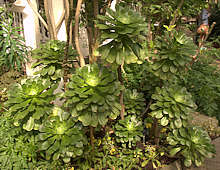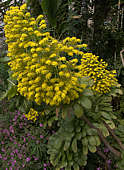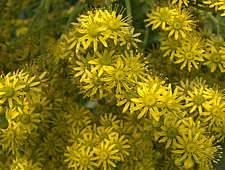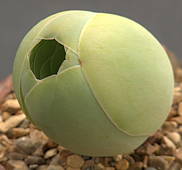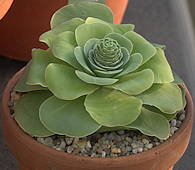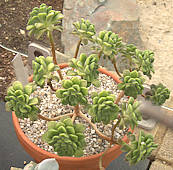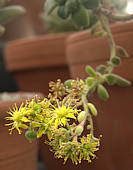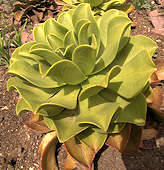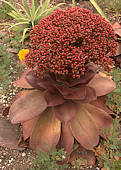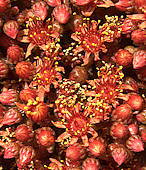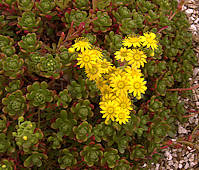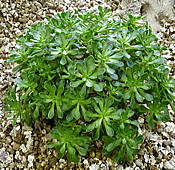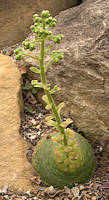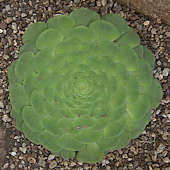Aeonium Webb & Berthelot 1840
Greek: aionion = everliving (attributed to Dioscorides).
The genus Aeonium includes at least 35 species of tender, rosetted, leaf succulents mainly from the Canary Islands but also found in Madeira, Morocco and Ethiopia. These succulent plants vary in size from small herbs almost flat against the ground to woody shrubs with stout basal stems supporting one or more disc-shaped rosettes, giving them a distinctive appearance. Flowers are panicles of numerous small yellow or white florets. Some Aeoniums are monocarpic.
Natural hybrids are common and there are many attractive horticultural hybrids and cutivars. The sap of Aeonium lindleyi is a traditional antidote to the toxic sap of Euphorbias e.g. E. canariensis.
Aeonium includes the former genera Greenonium and Greenovia (Mountain Roses), which may be seen occasionally on plant labels and in old books. Many species were originally classified as Sempervivums.
|
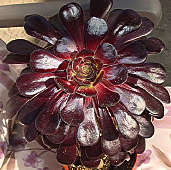
Above: photo Cherry Trenge 2003 |
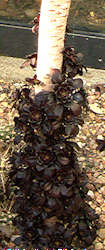 |
 |
Aeonium arboreum cv. Schwartzkopf (Zwartkop) Webb & Berthelot 1840
This selected cultivar has a large rosette of almost black succulent leaves which is often seen as a feature plant in summer bedding. There are several similar cultivars with black rosettes. The ordinary green Aeonium arboreum is commoner in nature but seen less frequently in cultivation. The green form colours up in full sun to a lesser extent.
A large Aeonium arboreum produces an impressive panicle of small yellow flowers (above) and then dies. The plant usually offsets along the stem (above middle left) before dying. Non-flowering rosettes on a flowering plant survive and can be propagated for the next year.
Aeonium arboreum is native to the Canary Islands. Several varieties have been described.
|
|
Aeonium aureum T.H.M. Mes 1995 Syn. Greenovia diplocycla Webb ex Bolle 1859
Under dry conditions the succulent leaves close up into a ball to conserve moisture, but this species is more usually seen as a spiralling 10in rosette of glaucous green leaves, often offsetting to form clumps. The inflorescence is a large panicle of small yellow flowers.
Native to lava cliffs of the Canary Islands (La Palma, El Hierro and la Gomera) at elevations of up to 6000ft above sea level.
|
 |
Aeonium canariense var. palmense H.Y. Liu 1989 Syn: Aeonium palmense
Native to the Canary Islands (La Plama, El Hierro).
|
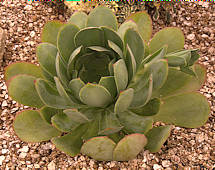 |
Aeonium cuneatum Webb & Berthelot 1840
Name: Latin cuneatum = wedge-shaped
This species has a very large stemless rosette of succulent leaves, sometimes clumping up by side shoots. The green leaves have a greyish coating which is easily spoiled by contact or by overhead watering. Leaf margins are reddened ciliate and there is a prominent reddened mucronate tip. The branching inflorescence has bright yellow flowers, opening flat.
Native to North-Eastern and North-Western Tenerife in the Canary Islands.
Seen on a display by Trewidden Nursery.
|
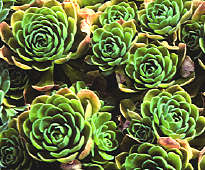 |
Aeonium decorum Webb ex Bolle 1859
This densely-branching succulent sub-shub has compact rosettes of ovate leaves, although the rosettes are planted out here as bedding.
Native to the Canary Islands (Gomera, Tenerife).
|
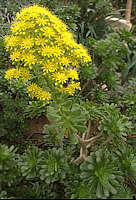 |
Aeonium gomerense Praeger 1928
Native to the Canary Islands (Gomera).
|
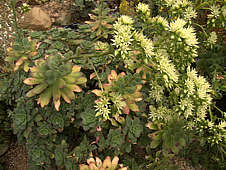 |
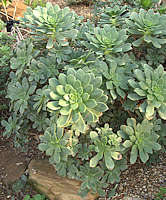 |
Aeonium haworthii Salm-Dyck ex Webb & Berthelot 1840
A densely-branched shrubby succulent plant with flat blue-green 4 in rosettes, becoming reddened along leaf margins and tips. Leaf margins are finely ciliate. The inflorescence is a loose cluster of cream star-like flowers.
Native to the Canary Islands (Tenerife).
|
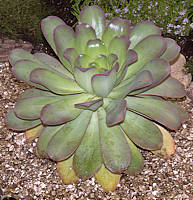 |
Aeonium hierrense (Murray) J. Pitard & L. Proust 1909 (Giant Houseleek)
A very large Aeonium with a broad rosette up to 30 in diameter, formed from spatulate leaves with reddened ciliate margins, on a 3 ft stem patterned with old leaf scars. The leaf tips are often concave. Flowers are whiteish to pink in a domed panicle.
Native to El Hierro Island in the Canary Islands, growing at elevations of up to 2700 ft.
Seen on a display by Trewidden Nursery.
|
 |
Aeonium leucoblepharum Webb ex Richard 1848
A perennial shrubby succulent plant. The older leaves of the light green rosettes become bronzed in strong light. The rounded ends of the leaves have a pointed tip and their margins are finely ciliate.
Native to Ethiopia, Kenya, Somalia, Uganda, Yemen, growing in mountains at elevations of 6500 - 11,000 ft.
|
|
Aeonium lindleyi Webb & Berthelot 1840
Named for: John Lindley (1799 - 1865) English botanist
This sub-shrub has woody greyish-brown branches bearing small rosettes of succulent, fleshy obovate-spathulate leaves which are slightly pubescent and sticky to the touch. The inflorescence is a long, pubescent flower stalk branching at its end with a cluster of bright yellow star-like flowers.
Native to the Canary Islands of Tenerife and La Palma, mostly growing at low elevations below 1000 ft above sea level.
The sap of Aeonium lindleyi is a traditional antidote to the toxic sap of Euphorbias.
|
|
Aeonium sedifolium J. Pitard & L. Proust 1909
Name: sedifolium = leaves like a Sedum
This dwarf succulent shrub grows up to 15 in tall. The succulent leaves are slightly sticky, with some variation in form from obovate to spatulate. They may be streaked with red. The inflorescence is a cluster of yellow flowers, produced in Spring to early Summer.
Native to the Canary Islands (Tenerife, La Palma ) growing on cliffs at moderate elevations.
Seen on a display by Trewidden Nursery.
|
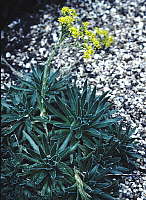 |
Aeonium simsii Stearn 1951
The bluish-green lanceolate leaves of this small succulent plant have ciliate margins. The inflorescence is a peduncle of a few tens of greenish-yellow flowers on a leafy flower stem, arising from a basal leaf axil of the rosette.
Native to the Canary Islands (Gran Canaria), growing at elevations of up to 6000 ft.
|
|
Aeonium tabuliforme Webb & Berthelot 1840
A flattened, stemless rosette of tightly-packed leaves up to 6in in diameter. Each leaf has a ciliated margin. This succulent plant is monocarpic and generally a biennial. When about to flower, the centre rises to surround the flower spike of many yellow flowers.
From the Canary Islands, especially cracks in lava cliffs of Tenerife where the plants grow at steep angles that prevent water from accumulating. Avoid getting water on the rosette.
|
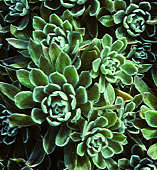
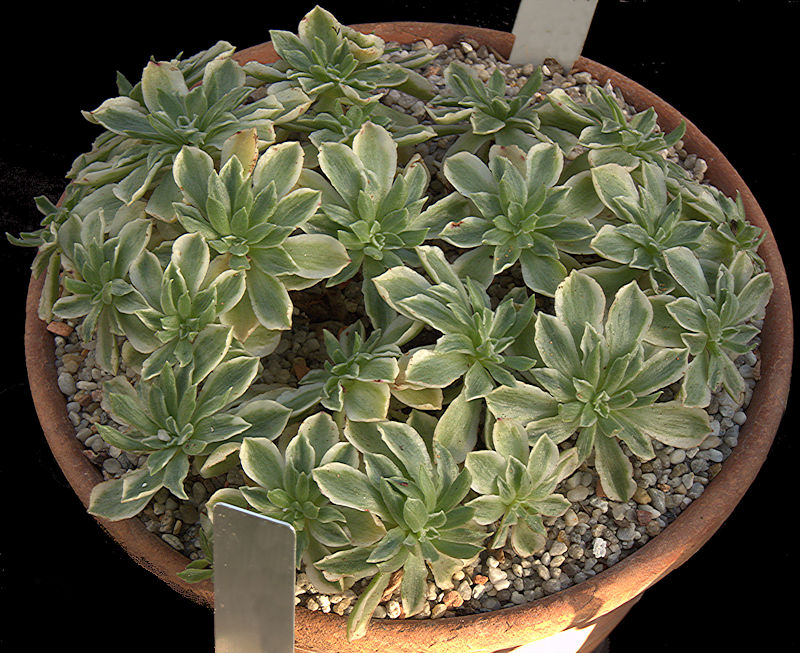 |
Aeonium sp.
Two plantings labelled as Aeonium goodii but I haven't been able to verify this as a valid name.
A distinctive succulent plant whose leaves have white margins.
See below: Aeonium goochiae cv. 'Ballerina'
|
Aeonium Hybrids and Cultivars
Natural hybridisation between Aeoniums is common and many attractive hybrids have been created by cross-breeding. The aim has often been to produce a more compact succulent plant instead of the "leggy" habit of many species. |
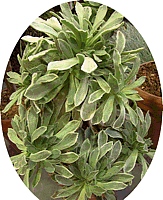 |
Aeonium goochiae cv. 'Ballerina' Gordon Rowley 1983
This succulent shrub makes a dense mass of rosettes of slightly hairy, greyish-green leaves with white margins. There is some variation in form of the slightly sticky leaves and reversion to the un-variegated form occurs occasionally. All-green rosettes should be removed or they will become dominant.
|
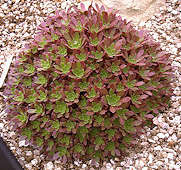 |
Aeonium x 'Cornish Tribute'
A compact, low growing hybrid, bred at Trewidden Nursery, that forms a mound of many small light red rosettes with green centres. The lanceolate leaves have ciliate margins.
|
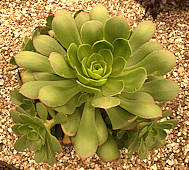 |
Aeonium 'Green Bay'
A cultivar with a large rosette. The leaves have reddened ciliate margins.
Seen on a display by Trewidden Nursery.
|
 |
Aeonium x 'Kiwi'
This Aeonium, thought to be a hybrid of Aeonium haworthii, has ovate green leaves with red margins. The newer leaves in the centre of the rosettes are yellow.
Seen on a display by Trewidden Nursery.
|
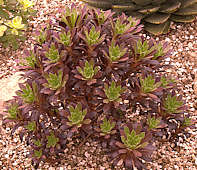 |
Aeonium x 'Logan Rock'
A freely branching, compact hybrid Aeonium, bred at Trewidden Nursery, whose purple rosettes have green centres.
|
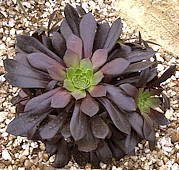 |
Aeonium x 'Poldark'
A naturally-branching compact hybrid whose very dark rosettes have a touch of green in their centre. The succulent leaves have ciliate margins.
Seen on a display by Trewidden Nursery.
|
 |
Aeonium simsii x schwarzkopf
A hybrid with dark red, almost black rosettes with bright green centres. The lanceolate leaves have ciliate margins.
Seen on a display by Trewidden Nursery.
|
 |
Cultivation
Aeoniums are easy to grow in a free-draining gritty compost on a sunny window ledge or the greenhouse. Aeoniums tolerate cool, frost-free conditions during the winter if kept dry. A few leaves may be dropped, but will soon be replaced in the Spring. Mealy bugs and vine weevils can be discouraged with a systemic insecticide. As with other Crassulaceae do not use Malathion.
Many Aeoniums are monocarpic and will die after flowering. However, non-flowering offsets on the plant will survive (left). New plants can be propagated from a rosette, which should ideally be cut with around an inch of basal stem below the leaves. Allow the cut end to dry off for a few days before potting up, and water sparingly until roots have formed.
Pests of Aeoniums include aphids, whitefly and mealy bugs. As with other Crassulaceae do not use Malathion and related insecticides. Watering with a systemic insecticide containing Imidacloprid will prevent infestation by most pests. If plants are kept outside during the Summer, it is a good idea to give a prophylactic dose before bringing indoors.
|









